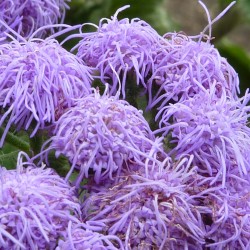Menu
-
Menuالعدمة
- Home
-
التصنيفات
-
-
التصنيفات
-
بذور الخضروات
-
أصناف حسب البلد
- أصناف من أرمينيا
- أصناف من البوسنة والهرسك
- أصناف من كرواتيا
- أصناف من فرنسا
- أصناف من ألمانيا
- أصناف من اليونان
- أصناف من المجر
- أصناف من الهند
- أصناف من إيطاليا
- أصناف من اليابان
- أصناف من شمال مقدونيا
- أصناف من بيرو
- أصناف من روسيا
- أصناف من صربيا
- أصناف من سلوفينيا
- أصناف من اسبانيا
- أصناف من تايلاند
- أصناف من تركيا
- أصناف من الولايات المتحدة الأمريكية
- بذور الطماطم
- بذور الذرة
- عائلة القرع
- الفول الأسرة
- بذور الخيار
- بذور الفلفل
- عائلة الجزرة
- عائلة البصل
- بذور الخس
- عائلة البطاطس
- عائلة الملفوف
- بذور الفجل
- عائلة الشمندر
- بذور البطيخ
- بذور بطيخ
- بذور القرنبيط
- عائلة عباد الشمس
-
أصناف حسب البلد
- بذور الفاكهة
- بذور الفلفل الحار
- بذور عشبة طبية
- تسلق بذور النباتات
- الأشجار - بذور بونساي
- بذور النخيل
- بذور الأعشاب الزينة
- بذور التبغ
-
بذور الخضروات
-
-
-
-
- منتجات جديدة
- التسليم - الدفع
- انشئ حساب
- FAQ
- الصفحة الرئيسية
-
- حزم كبيرة من البذور
- بذور النباتات العملاقة
- بذور الخضروات
- أصناف حسب البلد
- أصناف من أرمينيا
- أصناف من البوسنة والهرسك
- أصناف من كرواتيا
- أصناف من فرنسا
- أصناف من ألمانيا
- أصناف من اليونان
- أصناف من المجر
- أصناف من الهند
- أصناف من إيطاليا
- أصناف من اليابان
- أصناف من شمال مقدونيا
- أصناف من بيرو
- أصناف من روسيا
- أصناف من صربيا
- أصناف من سلوفينيا
- أصناف من اسبانيا
- أصناف من تايلاند
- أصناف من تركيا
- أصناف من الولايات المتحدة الأمريكية
- بذور الطماطم
- بذور الذرة
- عائلة القرع
- الفول الأسرة
- بذور الخيار
- بذور الفلفل
- عائلة الجزرة
- عائلة البصل
- بذور الخس
- عائلة البطاطس
- عائلة الملفوف
- بذور الفجل
- عائلة الشمندر
- بذور البطيخ
- بذور بطيخ
- بذور القرنبيط
- عائلة عباد الشمس
- أصناف حسب البلد
- بذور الفاكهة
- بذور الفلفل الحار
- بذور عشبة طبية
- تسلق بذور النباتات
- الأشجار - بذور بونساي
- بذور الموز
- بذور النخيل
- بذور الأعشاب الزينة
- بذور التبغ
- بذور زهرة
- بذور الصبار
- بذور النباتات المائية
- تعليمات البذر
- قوالب الفاكهة والخضروات
- فطر الفطر
- المصابيح النباتية
- بذور الخيزران
- نباتات الأيورفيدا
- F1 hybrid seeds
- التعبئة والتغليف والاشياء
- نباتات مقاومة للبرد
- منتجات العناية النباتية
- التوابل العضوية
- التسليم - الدفع
- لا دفع باي بال وبطاقة X
Last Product Reviews
Out of the two seeds, one germinated and the other one was dead and floatin...
By
 Riikka H on 07/03/2024
Riikka H on 07/03/2024
Verified Purchase
الأكثر مبيعاً
يوجد 1294 منتجا.
عرض 886-900 من 1294 منتجات
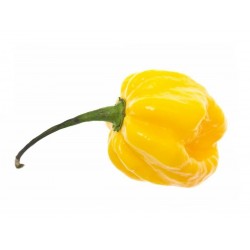
Scotch Bonnet Yellow Chili...
السعر
2.00 €
(SKU: C 89 Y)
Seeds Gallery EU,
5/
5
<div id="idTab1" class="rte">
<h2><span style="text-decoration:underline;"><em><strong>Scotch Bonnet Yellow Seeds</strong></em></span></h2>
<h3><span style="color:#ff0000;"><strong>Price for Package of 5 seeds.</strong></span></h3>
<div>Scotch bonnet is one of the most popular chilli peppers. This variety matures from green to yellow. The plant grows up to 1 metre tall and produces lots of fruits, 4-6cm long. Long growing season, most suitable for greenhouse production, february sowing.</div>
<div>Cultivation: Sow early December-January Under glass, or for maincrop March - April. Spacing 30-60cm x 45-90cm. The seeds germinate between 25 and 30°C. Grow on at 16-23°C. The seeds require good ventilation so do not further cover the seeds in bags/propagators unless absolutely necessary. </div>
<div>Harvest from early April/May, or maincrop from July.</div>
<div>Only water when the soil around the roots is dry as overwatering can produce a smaller crop of more sour tasting fruits. A ph level in the growing media that is slightly acidic is useful. </div>
<div>The seeds do not need sunlight to germinate, but once they sprout you need to place them under fluorescent lights for 10 to 16 hours per day. You can reduce the temperature to 70 degrees after they sprout. </div>
<div>A liquid feed with a good quality Tomato feed will be envigorate the plants once they are established but do not overwater/feed.</div>
<div>This variety may grow outdoors but they are best used as a greenhouse crop or perhaps on a nice sunny windowledge!</div>
</div>
C 89 Y

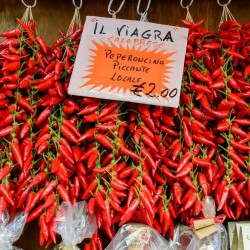
Italian PEPERONCINI Hot...
السعر
1.85 €
(SKU: C 67)
Seeds Gallery EU,
5/
5
<h2><strong>Italian PEPERONCINI Hot Chili Seeds</strong></h2>
<h2><span style="color:#ff0000;"><strong>Price for Package of 10 seeds.</strong></span></h2>
<p>The famous Italian hot Chili. Although it is an old Italian variety, it is now generally found only in the southern part of Italy. The plants grow up to some 40-50 centimeters in height and give truly plentiful fruits that grow upwards and are very hot.</p>
<p>The fruits are about 3 cm long and change color from green to red when ripe. We personally brought this Chili from Italy whose fruits we naturally dried in the sun and we can tell you that this variety is great for drying and grinding. Otherwise, given that the plant is small compact, this Chili is also great for growing in pots.</p>
<p>If you bring the pot inside the house before winter - next year you will already have the ripe fruits of this excellent and hot Chili in May ...</p>
C 67


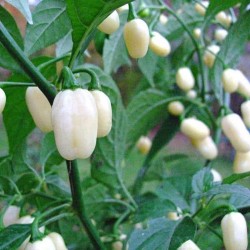
Habanero White Seeds
السعر
1.85 €
(SKU: C 10 W)
Seeds Gallery EU,
5/
5
<h2><span style="text-decoration:underline;"><em><strong>Habanero White Seeds</strong></em></span></h2>
<h3><span style="color:#ff0000;"><strong>Price for Package of 3 seeds.</strong></span></h3>
<div>The White Habanero also known as 'Peruvian White Habanero' is a lovely and rare variety that is hard to come by and said to originate from Peru. <span style="font-size:11px;line-height:1.5em;">These fiery hot jelly bean shaped peppers grow on small, but very high yielding bushy pepper plants with the creamy-white coloured pods measuring 5cm (2in) long by 2cm (¾in) in diameter. </span></div>
<div> </div>
<div>If you like searing hot chillies, this could be the one for you as they have been rated at over 300,000 Scoville heat units. These awesomely hot chillies have a distinctive smoky flavour and the creamy-white fruits make for striking plants. </div>
<div>The plant grows to around 45cm tall (18in). They will grow happily outside over the summer in pots, or planted into the garden, but bring them in before the first frosts to prolong fruiting. </div>
<div>Maturing in around 90 days, this is a rare and unusual chilli for your collection.</div>
<div> </div>
<div> </div>
<div>Storage of Seeds: </div>
<div>Store seeds away from children, sealed in their packaging in a cool, dry, dark place, or in a fridge. Never store them in a freezer as the sudden temperature drop is likely to kill them. Don't leave the seeds in direct sunlight as the heat generated may kill them.</div>
<div> </div>
<div>Sowing: Sow from mid February to mid June</div>
<div>The temperature, moisture, and air circulation all play a role in growing plants from seeds. Too little heat, too much moisture, and lack of air circulation will cause poor results. Do not use jiffy peat pots, plugs, or potting soil as the soil becomes too dry or too wet, which can lead to low germination, disease and fungus.</div>
<div> </div>
<div>Fill small cells or trays with a good sterile seed compost and sow the seeds on the surface. “Just cover” with a fine sprinkling (3mm) of soil or vermiculite.</div>
<div>Keep the compost moist - don't let the top of the compost dry out (a common cause of germination failure) If you wish, spray the surface with a dilute copper-based fungicide.</div>
<div>Cover the pot or tray with plastic film or place in a heated propagator, south facing window or a warm greenhouse. </div>
<div>The ideal temperature is around 18 to 20°C (65 to 72°F)</div>
<div> </div>
<div>Transplanting: </div>
<div>When the seedlings have produced their first pair of true leaves they can be potted on into individual 7 to 10cm (3 to 4in) pots. Use good quality potting compost and mix in some organic slow release fertiliser. Pot the chilli on again before it becomes root-bound.</div>
<div>Water the seedlings regularly, but don't let them become waterlogged as this encourages rot. Don't let them dry out as they rarely recover at this stage. Water the soil, not the foliage. Once the plants have established, it is better to water heavy and infrequently, allow the top inch or so to dry out in between watering.</div>
<div> </div>
<div>Seedlings should be grown in good light, but should not be exposed to direct sunlight from late spring to early autumn. Weaker sunlight from autumn to spring is unlikely to do them harm. Once seedlings have put on some growth they need lots of light. Growing them under a grow-light produces excellent stocky plants, as will a warm sunny windowsill. Adult chilli plants need lots of light. However, more than 4 hours or so in hot direct sunlight will dry them out quickly.</div>
<div>Acclimatise to outdoor conditions for 2 to 3 weeks before they are moved permanently outside. Plant them into rich moist soil. Flower do not form and fruit will not set if the temperature is much below 17°C (62°F) for most of the day, so wait until June/July for best results with outdoor planting.</div>
<div> </div>
<div>Fertilising: </div>
<div>After the first flowers appear, feed every 1 or 2 weeks with a half-strength liquid tomato feed. You could also add Seaweed extract to the water once a week.</div>
<div> </div>
<div>Pollinating Flowers: (optional)</div>
<div>Chilli plants are self fertile and will generally pollinate themselves. However, if you want to give them a helping hand to ensure that lots of fruit are set indoors, use a cotton wool bud to gently sweep the inside of the flowers, spreading the pollen as you go. The flower's petals will drop off as the green middle part of the flower starts to swell slightly. This is the chilli pepper beginning to grow.</div>
<div> </div>
<div>Harvesting: Harvest in approx 90 days</div>
<div>Harvest any time after they are fully developed but the longer you leave them on the hotter they will become. Harvest peppers as they mature to encourage new buds to form. Use scissors so you don't damage the plant.</div>
<div> </div>
<div>Storage: </div>
<div>After picking eat fresh or dry the peppers by putting them into a mesh bag, hang the bag up in a dry, airy, but not sunny spot. When they are completely dry, you can make paprika by grinding the peppers. Don't grind the stalks. You can regulate the spiciness of the result by including more or less of the seeds and veins.</div>
<div> </div>
<div>WARNING: </div>
<div>Be careful handling chilli seeds as they can cause a painful burning sensation: Avoid contact with the eyes or any sensitive skin before washing your hands thoroughly.</div>
<p>These peppers are very hot please make sure whomever tries them knows before-hand !</p>
<table class="data-table" cellspacing="0"><tbody><tr class="first odd"><td class="label"><strong><span style="color:#008000;">Packet Size</span></strong></td>
<td class="data last"><span style="color:#008000;">3 Seeds</span></td>
</tr><tr class="even"><td class="label"><strong><span style="color:#008000;">Common Name</span></strong></td>
<td class="data last"><span style="color:#008000;">Peruvian White Habanero </span><br /><span style="color:#008000;">Very Hot, over 300,000 Scoville units</span></td>
</tr><tr class="odd"><td class="label"><strong><span style="color:#008000;">Other Common Names</span></strong></td>
<td class="data last"><span style="color:#008000;">Chili, Chile or Chilli. Hot Peppers.</span></td>
</tr><tr class="even"><td class="label"><strong><span style="color:#008000;">Family</span></strong></td>
<td class="data last"><span style="color:#008000;">Solanaceae</span></td>
</tr><tr class="odd"><td class="label"><strong><span style="color:#008000;">Genus</span></strong></td>
<td class="data last"><span style="color:#008000;">Capsicum</span></td>
</tr><tr class="even"><td class="label"><strong><span style="color:#008000;">Species</span></strong></td>
<td class="data last"><span style="color:#008000;">chinense</span></td>
</tr><tr class="odd"><td class="label"><strong><span style="color:#008000;">Cultivar</span></strong></td>
<td class="data last"><span style="color:#008000;">White Habanero</span></td>
</tr><tr class="even"><td class="label"><strong><span style="color:#008000;">Synonym</span></strong></td>
<td class="data last"><span style="color:#008000;">Peruvian or Yucatan White Habanero</span></td>
</tr><tr class="odd"><td class="label"><strong><span style="color:#008000;">Hardiness</span></strong></td>
<td class="data last"><span style="color:#008000;">Tender Perennial</span></td>
</tr><tr class="even"><td class="label"><strong><span style="color:#008000;">Height</span></strong></td>
<td class="data last"><span style="color:#008000;">Grows to around 45cm (18 in) tall</span></td>
</tr><tr class="odd"><td class="label"><strong><span style="color:#008000;">Position</span></strong></td>
<td class="data last"><span style="color:#008000;">Grown in good light, but should not be exposed to direct sunlight</span></td>
</tr><tr class="even"><td class="label"><strong><span style="color:#008000;">Soil</span></strong></td>
<td class="data last"><span style="color:#008000;">Rich moist soil.</span></td>
</tr><tr class="odd"><td class="label"><strong><span style="color:#008000;">Time to Sow</span></strong></td>
<td class="data last"><span style="color:#008000;">Sow from mid February to mid June</span></td>
</tr><tr class="even"><td class="label"><strong><span style="color:#008000;">Harvest</span></strong></td>
<td class="data last"><span style="color:#008000;">The longer you leave them on the hotter they will become</span></td>
</tr><tr class="last odd"><td class="label"><strong><span style="color:#008000;">Time to Harvest</span></strong></td>
<td class="data last"><span style="color:#008000;">90 days</span></td>
</tr></tbody></table>
C 10 W

- على الإنترنت فقط!
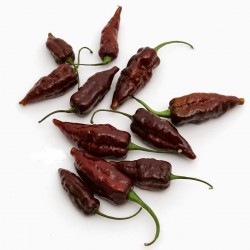
Fatalii Choco Chili Seeds
السعر
2.50 €
(SKU: C 29 C)
Seeds Gallery EU,
5/
5
<h2><span style="text-decoration: underline;" class=""><em><strong>Fatalii Choco Chili Seeds</strong></em></span></h2>
<h3><span style="color: #ff0000;"><strong>Price for Package of 5 seeds.<br></strong></span></h3>
<div>The Fatalii is a chili pepper of Capsicum chinense that originates in central and southern Africa. It is described to have a fruity, citrus flavor with a searing heat that is comparable to the standard habanero. The Scoville Food Institute lists the Fatalii as the sixth hottest pepper with Scoville units ranging from 125,000 ~ 325,000 units.</div>
<div><strong>Cultivation</strong></div>
<div>The plants grow 20 to 25 inches in height, and plant distance should be about the same. The pendant pods get 2.5 to 3.5 inches long and about 0.75 to 1.5 inches wide. From a pale green, they mature to a bright yellow (there are red Fataliis around as well, but the yellow one is the "real thing.")</div>
<div><strong>Culinary Use</strong></div>
<div>The Fatalii is known for its extreme heat and citrus flavor. As such, it makes for a unique hot sauce that usually comprises other citrus flavors (e.g., lime, lemon). The walls of the peppers are very thin, making it very easy to dry. After drying, the peppers can be used as powders.</div><script src="//cdn.public.n1ed.com/G3OMDFLT/widgets.js"></script>
C 29 C


نبات مقاوم للبرد والصقيع
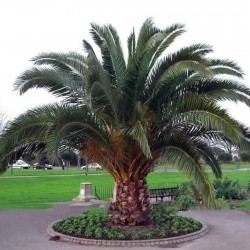
نخلة كنارية بذور
السعر
2.75 €
(SKU: PS 5)
Seeds Gallery EU,
5/
5
<h2 id="short_description_content"><strong>(Phoenix canariensis) نخلة كنارية بذور</strong></h2>
<h2><span style="color: #ff0000;"><strong>ثمن عبوة 10, 50 بذور.</strong></span></h2>
<p>نخلة كنارية الاسم العلمي:Phoenix canariensis هي نوع من النباتات يتبع جنس النخلة من الفصيلة الفوفلية .</p>
<p>Phoenix canariensis is a species of flowering plant in the palm family Arecaceae, native to the Canary Islands. It is a relative of Phoenix dactylifera, the true date palm. It is the natural symbol of the Canary Islands, together with the canary Serinus canaria.</p>
<p><strong>Description</strong></p>
<p>Phoenix canariensis is a large solitary palm, 10–20 m (33–66 ft) tall, occasionally growing to 40 m (131 ft). The leaves are pinnate, 4–6 m (13–20 ft) long, with 80–100 leaflets on each side of the central rachis. The fruit is an oval, yellow to orange drupe 2 cm (0.79 in) long and 1 cm (0.39 in) in diameter and containing a single large seed; the fruit pulp is edible but too thin to be worth eating.</p>
<p><strong>Names</strong></p>
<p>The most used common name in English is Canary Island Date Palm. The common name in Spanish speaking countries and in the Canary Islands is palmera canaria. It has sometimes mistakenly been called a pineapple palm but, it is not related to pineapples at all, which are grown low to the ground and not on trees.</p>
<p><strong>Cultivation</strong></p>
<p>The Canary Island date palm is very widely planted as an ornamental plant in warm temperate regions of the world, particularly in areas with Mediterranean climates but also in some areas with a mild oceanic climate, such as Ireland and the Channel Islands.[2] It can be cultivated where temperatures never fall below −10 or −12 °C (14 or 10 °F) for extended periods, although it will require some protection if cold periods are longer than normal.</p>
<p>The palm is easily recognized through its crown of leaves and trunk characteristics. It is not uncommon to see Canary Island date palms pruned and trimmed to enhance the appearance.</p>
<p> When pruned, the bottom of the crown, also called the nut, appears to have a pineapple shape.</p>
<p><strong>It has gained the Royal Horticultural Society's Award of Garden Merit.</strong></p>
<p><strong>Other uses</strong></p>
<p>In the Canary Islands, the sap of this date palm is used to make palm syrup. La Gomera is where most of the sap is produced in the Canary Islands.</p>
<p><strong>Invasiveness</strong></p>
<p>In some mediterranean and subtropical countries, P. canariensis has proven to be an invasive plant. In New Zealand, it has invaded a range of habitats. New Zealand's Landcare Research has classified the palm as a 'sleeper weed' - "a plant that spreads slowly and goes unnoticed until it becomes widespread". It is also considered naturalised in Spain, Italy, Australia, Bermuda and parts of the United States (California, Arizona, Florida and Alabama).[5][6] In Auckland, New Zealand, the palm has itself become a host for the naturalised Australian strangler fig, Ficus macrophylla.</p><script src="//cdn.public.n1ed.com/G3OMDFLT/widgets.js"></script>
PS 5 (10 S)


نبات مقاوم للبرد والصقيع
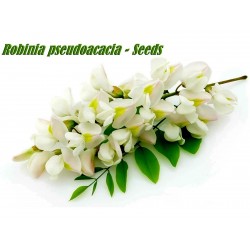
White Wisteria Seeds...
السعر
2.00 €
(SKU: T 45)
Seeds Gallery EU,
5/
5
<div id="idTab1" class="rte">
<h2><span style="font-size: 14pt;"><strong>White Wisteria Seeds (Robinia pseudoacacia)</strong></span></h2>
<h2><span style="color: #ff0000; font-size: 14pt;"><strong>Price for Package of 20 seeds.</strong></span></h2>
<p>Robinia pseudoacacia, commonly known as the White Wisteria, is a tree of the genus Robinia in the subfamily Faboideae of the pea family Fabaceae. It is native to the southeastern United States, but has been widely planted and naturalized elsewhere in temperate North America, Europe, Southern Africa and Asia and is considered an invasive species in some areas. A less frequently used common name is false Acacia, which is a literal translation of the specific epithet. It was introduced into Britain in 1636.</p>
<p><strong>Description</strong></p>
<p>With a trunk up to 0.8 m diameter (exceptionally up to 52 m tall[2] and 1.6 m diameter in very old trees), with thick, deeply furrowed blackish bark. The leaves are 10–25 cm long, pinnate with 9–19 oval leaflets, 2–5 cm long and 1.5–3 cm broad. Each leaf usually has a pair of short spines at the base, 1–2 mm long or absent on adult crown shoots, up to 2 cm long on vigorous young plants. The intensely fragrant (reminiscent of orange blossoms) flowers are white to lavender or purple, borne in pendulous racemes 8–20 cm long, and are edible. The fruit is a legume 5–10 cm long, containing 4–10 seeds.</p>
<p>Although similar in general appearance to the honey locust, it lacks that tree’s characteristic long branched thorns on the trunk, instead having the pairs of short spines at the base of each leaf; the leaflets are also much broader.</p>
<p>The black locust is native in the United States from Pennsylvania to northern Georgia and westward as far as Arkansas and Oklahoma, but has been widely spread. The tree reaches a height of seventy feet, with a trunk three or four feet in diameter and brittle branches that form an oblong narrow head. It spreads by underground shoots. The leaflets fold together in wet weather and at night; some change of position at night is a habit of the entire leguminous family.</p>
<p>Bark: Dark gray brown tinged with red, deeply furrowed, surface inclined to scale. Branchlets at first coated with white silvery down. This soon disappears and they become pale green, afterward reddish brown. Prickles develop from stipules, are short, somewhat triangular, dilated at base, sharp, dark purple, adhering only to the bark, but persistent.</p>
<p><strong>Wood</strong>: Pale yellowish brown; heavy, hard, strong, close-grained and very durable in contact with the ground. The wood has a specific gravity 0.7333, and a weight of approximately 45.7 pounds per cubic foot</p>
<p><strong>Winter buds</strong>: Minute, naked, three or four together, protected in a depression by a scale-like covering lined on the inner surface with a thick coat of tomentum and opening in early spring; when forming are covered by the swollen base of the petiole.</p>
<p><strong>Leaves</strong>: Parallel, compound, odd-pinnate, 21-40 inches long, with slender hairy petioles, grooved and swollen at the base. Leaflets petiolate, seven to nine, one to two inches long, one-half to three-fourths of an inch broad, emarginate or rounded at apex. They come out of the bud conduplicate, yellow green, covered with silvery down which soon disappears; when full grown are dull dark green above, paler beneath. Feather-veined, midvein prominent. In autumn they turn a clear pale yellow. Leafs out relatively late in spring. Stipules linear, downy, membranous at first, ultimately developing into hard woody prickles, straight or slightly curved. Each leaflet has a minute stipel which quickly falls and a short petiole.</p>
<p><strong>Flowers</strong>: May or June, after the leaves. Papilionaceous. Perfect, borne in loose drooping racemes four to five inches long, cream-white, about an inch long, nectar bearing, fragrant. Pedicels slender, half an inch long, dark red or reddish green.</p>
<p><strong>Calyx</strong>: Campanulate, gibbous, hairy, five-toothed, slightly two-lipped, dark green blotched with red, especially on the upper side teeth valvate in bud.</p>
<p><strong>Corolla</strong>: Imperfectly papilionaceous, petals inserted upon a tubular disk; standard white with pale yellow blotch; wings white, oblong-falcate; keel petals incurved, obtuse, united below.</p>
<p><strong>Stamens</strong>: Ten, inserted, with the petals, diadelphous, nine inferior, united into a tube which is cleft on the upper side, superior one free at the base. Anthers two-celled, cells opening longitudinally.</p>
<p><strong>Pistil</strong>: Ovary superior, linear-oblong, stipitate, one-celled; style inflexed, long, slender, bearded; stigma capitate; ovules several, two-ranked.</p>
<p><strong>Fruit</strong>: legume two-valved, smooth three to four inches long and half an inch broad, usually four to eight seeded. Ripens late in autumn and hangs on the branches until early spring. Seeds dark orange brown with irregular markings. Cotyledons oval, fleshy.</p>
<p><strong>Cultivation</strong></p>
<p>Black locust is a major honey plant in the eastern US, and, having been taken and planted in France, Italy and other European nations. At least In France and Italy it is the source of the renowned acacia monofloral honey. Flowering starts after 140 growing degree days. However, its blooming period is short (about 10 days) and it does not consistently produce a honey crop year after year. Weather conditions can have quite an effect on the amount of nectar collected as well; in Ohio state for example, good locust honey flow happens in one out of five years.</p>
<p>In Europe it is often planted alongside streets and in parks, especially in large cities, because it tolerates pollution well. The species is unsuitable for small gardens due to its large size and rapid growth, but the cultivar ‘Frisia’, a selection with bright yellow-green leaves, is occasionally planted as an ornamental tree.</p>
<p>In South Africa it is regarded as a weed because of its habit of freely suckering from roots near the surface and aggravated by cutting of the main stem.</p>
<p>Black locust has nitrogen-fixing bacteria on its root system; for this reason it can grow on poor soils and is an early colonizer of disturbed areas.</p>
<p>In 1900 it was reported that the value of Robinia pseudoacacia was practically destroyed in nearly all parts of the United States beyond the mountain forests which are its home by locust borers which riddle the trunk and branches. Were it not for these insects, it would be one of the most valuable timber trees that could be planted in the northern and middle states. Young trees grow quickly and vigorously for a number of years, but soon become stunted and diseased, and rarely live long enough to attain any commercial value.</p>
<p><strong>Flavonoids content</strong></p>
<p>Black locust leaves contain flavone glycosides characterised by spectroscopic and chemical methods as the 7-O-β-d-glucuronopyranosyl-(1 → 2)[α-l-rhamnopyranosyl-(1 → 6)]-β-d-glucopyranosides of acacetin (5,7-dihydroxy-4′-methoxyflavone), apigenin (5,7,4′-trihydroxyflavone), diosmetin (5,7,3′-trihydroxy-4′-methoxyflavone) and luteolin (5,7,3′,4′-tetrahydroxyflavone).</p>
<p><strong>Uses</strong></p>
<p>The wood is extremely hard, resistant to rot and durable, making it prized for furniture, flooring, paneling, fence posts and small watercraft. Wet, newly-cut planks have an offensive odour which disappears with seasoning. As a young man, Abraham Lincoln spent much of his time splitting rails and fence posts from black locust logs. Black locust is still in use in rustic handrail systems. Flavonoids in the heartwood allow the wood to last over 100 years in soil.[7] In the Netherlands and some other parts of Europe, black locust is one of the most rot-resistant local trees, and projects have started to limit the use of tropical wood by promoting this tree and creating plantations. It is one of the heaviest and hardest woods in North America.</p>
<p>Black locust is highly valued as firewood for wood-burning stoves; it burns slowly, with little visible flame or smoke, and has a higher heat content than any other species that grows widely in the Eastern United States, comparable to the heat content of anthracite.[8] It is most easily ignited by insertion into a hot stove with an established coal bed.[citation needed] For best results it should be seasoned like any other hardwood, however black locust is also popular because of its ability to burn even when wet.[9] In fireplaces it can be less satisfactory because knots and beetle damage make the wood prone “spitting” coals for distances of up to several feet.[citation needed] If the black locust is cut, split, and cured while relatively young (within ten years), thus minimizing beetle damage, “spitting” problems are minimal.</p>
<p>It is also planted for firewood because it grows rapidly, is highly resilient in a variety of soils, and it grows back even faster from its stump after harvest by using the existing root system.</p>
<p>With fertilizer prices rising, the importance of black locust as a nitrogen-fixing species is also noteworthy. The mass application of fertilizers in agriculture and forestry is increasingly expensive; therefore nitrogen-fixing tree and shrub species are gaining importance in managed forestry.</p>
<p>In traditional medicine of India different parts of Robinia pseudoacacia are used as laxative, antispasmodic, and diuretic.</p>
<p><strong>Toxicity</strong></p>
<p>Black locust’s pods are small and light, and easily carried long distances. Although the bark and leaves are toxic, various reports suggest that the seeds and the young pods of the black locust are edible. Shelled seeds are safe to harvest from summer through fall, and are edible both raw and/or boiled.[12] Due to the small nature of Black Locust seeds, shelling them efficiently can prove tedious and difficult. In France and in Italy Robinia pseudoacacia flowers are eaten as beignets after being coated in batter and fried in oil. [13] Important constituents of the plant are the toxalbumin robin, which loses its toxicity when heated and robinin, a non-toxic glucoside.[14] Horses that consume the plant show signs of anorexia, depression, incontinence, colic, weakness, and cardiac arrhythmia. Symptoms usually occur about 1 hour following consumption, and immediate veterinary attention is required.</p>
<p><strong>History</strong></p>
<p>The name locust is said to have been given to Robinia by Jesuit missionaries, who fancied that this was the tree that supported St. John in the wilderness, but it is native only to North America. The locust tree of Spain (Ceratonia siliqua or Carob Tree), which is also native to Syria and the entire Mediterranean basin, is supposed to be the true locust of the New Testament.</p>
<p>Robinia is now a North American genus, but traces of it are found in the Eocene and Miocene rocks of Europe.</p>
</div>
T 45 (20 S)

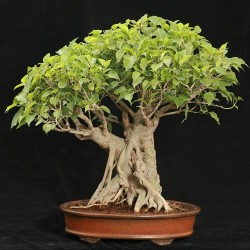
Sacred Fig Seeds (Ficus...
السعر
2.45 €
(SKU: T 34)
Seeds Gallery EU,
5/
5
<h2><strong>Sacred Fig Seeds (Ficus religiosa)</strong></h2>
<h2><span style="color:#ff0000;"><strong>Price for Package of 20 seeds.</strong></span></h2>
<div>Ficus religiosa or Sacred Fig is species of fig native to India, Bangladesh, Nepal, Pakistan, Sri Lanka, southwest China and Indochina. It belongs to the Moraceae, the fig or mulberry family. It is also known as Bo-Tree (from the Sanskrit Bodhi: "wisdom", "enlightened", and as a Sinhalization of this the Sinhala Bo) or [1] Peepal (in India),.</div>
<div>Ficus religiosa is a large dry season-deciduous or semi-evergreen tree up to 30 metres (98 ft) tall and with a trunk diameter of up to 3 metres (9.8 ft). The leaves are cordate in shape with a distinctive extended tip; they are 10–17 cm long and 8–12 cm broad, with a 6–10 cm petiole. The fruit is a small fig 1-1.5 cm diameter, green ripening to purple.</div>
<div>Buddhist legend tells of Gautama Buddha attained enlightenment (bodhi) while meditating underneath the Bodhi tree, a Ficus religiosa. The site is in present day Bodh Gaya, northern India. The Bodhi tree and the Sri Maha Bodhi propagated from it are notable specimens of Sacred Fig. The known planting date of the latter, 288 BCE, gives it the oldest verified age for any flowering plant (angiosperm).</div>
<div>In Theravada Buddhist Southeast Asia, the tree's massive trunk is often the site of Buddhist or animist shrines.</div>
<div>Not all Ficus religiosa can be called a 'Bodhi tree'. A 'Bodhi tree' must be able to trace its parent to another Bodhi tree and the line goes on until the first Bodhi tree under which the Lord Gautama Buddha gained enlightenment.</div>
<div>Sadhus (Hindu ascetics) still meditate beneath sacred fig trees, and Hindus do pradakshina (circumambulation) around the sacred fig tree as a mark of worship. Usually seven pradakshinas are done around the tree in the morning time chanting "Vriksha Rajaya Namah", meaning "salutation to the king of trees."</div>
<div>Plaksa is a possible Sanskrit term for Ficus religiosa. However, according to Macdonell and Keith (1912), it denotes the Wavy-leaved Fig tree (Ficus infectoria) instead.</div>
<div>In Hindu texts, the Plaksa tree is associated with the source of the Sarasvati River. The Skanda Purana states that the Sarasvati originates from the water pot of Brahma and flows from Plaksa on the Himalayas. According to Vamana Purana 32.1-4, the Sarasvati was rising from the Plaksa tree (Pipal tree).</div>
<div>Plaksa Pra-sravana denotes the place where the Sarasvati appears.[5] In the Rigveda Sutras, Plaksa Pra-sravana refers to the source of the Sarasvati.</div>
<p>Ficus religiosa is used in traditional medicine for about 50 types of disorders including asthma, diabetes, diarrhea, epilepsy, gastric problems, inflammatory disorders, infectious and sexual disorders.</p>
<table cellspacing="0" cellpadding="0" border="1"><tbody><tr><td colspan="2" width="100%" valign="top">
<h3 align="center"><span style="color:#008000;"><strong>Sowing Instructions</strong></span></h3>
</td>
</tr><tr><td valign="top" nowrap="nowrap">
<p align="center"><span style="color:#008000;"><strong>Propagation:</strong></span></p>
</td>
<td valign="top">
<p align="center"><span style="color:#008000;">Seeds</span></p>
</td>
</tr><tr><td valign="top" nowrap="nowrap">
<p align="center"><span style="color:#008000;"><strong>Pretreat:</strong></span></p>
</td>
<td valign="top">
<p align="center"><span style="color:#008000;">0</span></p>
</td>
</tr><tr><td valign="top" nowrap="nowrap">
<p align="center"><span style="color:#008000;"><strong>Stratification:</strong></span></p>
</td>
<td valign="top">
<p align="center"><span style="color:#008000;">0</span></p>
</td>
</tr><tr><td valign="top" nowrap="nowrap">
<p align="center"><span style="color:#008000;"><strong>Sowing Time:</strong></span></p>
</td>
<td valign="top">
<p align="center"><span style="color:#008000;">all year round</span></p>
</td>
</tr><tr><td valign="top" nowrap="nowrap">
<p align="center"><span style="color:#008000;"><strong>Sowing Depth:</strong></span></p>
</td>
<td valign="top">
<p><span style="color:#008000;">Needs Light to germinate!</span></p>
<p><span style="color:#008000;">Just sprinkle on the surface of the substrate + gently press</span></p>
</td>
</tr><tr><td valign="top" nowrap="nowrap">
<p align="center"><span style="color:#008000;"><strong>Sowing Mix:</strong></span></p>
</td>
<td valign="top">
<p align="center"><span style="color:#008000;">Coir or sowing mix + sand or perlite</span></p>
</td>
</tr><tr><td valign="top" nowrap="nowrap">
<p align="center"><span style="color:#008000;"><strong>Germination temperature:</strong></span></p>
</td>
<td valign="top">
<p align="center"><span style="color:#008000;">25-27°C</span></p>
</td>
</tr><tr><td valign="top" nowrap="nowrap">
<p align="center"><span style="color:#008000;"><strong>Location:</strong></span></p>
</td>
<td valign="top">
<p align="center"><span style="color:#008000;">bright + keep constantly moist not wet</span></p>
</td>
</tr><tr><td valign="top" nowrap="nowrap">
<p align="center"><span style="color:#008000;"><strong>Germination Time:</strong></span></p>
</td>
<td valign="top">
<p align="center"><span style="color:#008000;">3 - 6 weeks</span></p>
</td>
</tr><tr><td valign="top" nowrap="nowrap">
<p align="center"><span style="color:#008000;"><strong>Watering:</strong></span></p>
</td>
<td valign="top">
<p align="center"><span style="color:#008000;">Water regularly during the growing season</span></p>
</td>
</tr><tr><td valign="top" nowrap="nowrap"><span style="color:#008000;"> </span></td>
<td valign="top">
<p align="center"><br /><span style="color:#008000;"><em>Copyright © 2012 Seeds Gallery - Saatgut Galerie - Galerija semena. </em><em>All Rights Reserved.</em></span></p>
</td>
</tr></tbody></table>
T 34

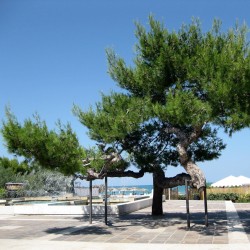
Jerusalem Pine Seeds
السعر
1.75 €
(SKU: T 28)
Seeds Gallery EU,
5/
5
<div id="idTab1" class="rte">
<h2><span style="font-size:14pt;"><strong>Jerusalem Pine Seeds (Pinus Halepensis)</strong></span></h2>
<h2><span style="color:#ff0000;font-size:14pt;"><strong>Price for Package of 5 seeds.</strong></span></h2>
<p>The Aleppo Pine tree is a Maltese indigenous tree and grows in most Mediterranean countries. It is a coniferous, evergreen tree. It is a small to medium-sized tree, reaching 15-25m of length and with a trunk diameter of up to 60cm. The leaves are very slender like ‘needles’ and are 6-12cm long, light green in colour and produced in pairs. The cones are 5-8cm long and 2-3cm broad at the base when closed, green at first, ripening to brown when 24 months old. They open slowly over the next few years, a process quickened if they are exposed to heat such as in forest fires. The cones open wide to allow the seeds to disperse. The seeds are 5-6mm long, with a 20mm wing, and are wind-dispersed. Aleppo pine reproduces by seed only. Seeds are mostly shed during summer. Up to 90% of seeds can germinate. The tree starts producing after its fourth year.</p>
<p>There are no male or female Aleppo Pine trees, but the tree produces male and female cones which start growing in autumn. Female cones are usually closer to the top and grow as individuals. Male cones grow in clusters. The one that we normally think of as a ‘cone’ is the female cone that produces the seeds. Since the male cones are full of pollen which is dispersed by the slightest movement, female cones are wind pollinated.</p>
<p>When one of the branches of the Aleppo Pine tree is cut off, the tree will never again grow another branch from the same place but will remain without that branch for the rest of its life. When a branch is cut off, a sticky substance called „resin‟ comes out from the tree trunk. This is a natural disinfectant which the tree produces to disinfect its wound. In colder countries, where a similar species of pine is cut down to produce timber and paper, this resin is collected and used in pine disinfectant.</p>
</div>
T 28

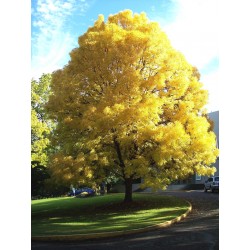
European ash Seeds
السعر
1.50 €
(SKU: T 22)
Seeds Gallery EU,
5/
5
<!DOCTYPE html>
<html>
<head>
<meta http-equiv="Content-Type" content="text/html; charset=UTF-8" />
</head>
<body>
<h2><span style="font-size: 14pt;"><strong>European ash Seeds (Fraxinus excelsior)</strong></span></h2>
<h2><span style="color: #ff0000;"><strong><span style="font-size: 14pt;">Price for Package of 20 seeds.</span></strong></span></h2>
<div>Fraxinus excelsior — known as the ash, or European ash or common ash to distinguish it from other types of ash — is a species of Fraxinus native to most of Europe with the exception of northern Scandinavia and southern Iberia, and also southwestern Asia from northern Turkey east to the Caucasus and Alborz mountains. The northernmost location is in the Trondheimsfjord region of Norway. it is a large deciduous tree growing to 20–35 m (exceptionally to 46 m) tall with a trunk up to 2 m (exceptionally to 3.5 m) diameter, with a tall, domed crown. The bark is smooth and pale grey on young trees, becoming thick and vertically fissured on old trees. The shoots are stout, greenish-grey, with jet black buds (which distinguish it from most other ash species, which have grey or brown buds). The leaves are 20–35 cm long, pinnate compound, with 7-13 leaflets, the leaflets 3–12 cm long and 0.8–3 cm broad, sessile on the leaf rachis, and with a serrated margin. The leaves are often among the last to open in spring, and the first to fall in autumn if an early frost strikes; they have no marked autumn colour, often falling dull green. The flowers open before the leaves, the female flowers being somewhat longer than the male flowers; they are dark purple, and without petals, and are wind-pollinated. Both male and female flowers can occur on the same tree, but it is more common to find all male and all female trees; a tree that is all male one year can produce female flowers the next, and similarly a female tree can become male. The fruit is a samara 2.5-4.5 cm long and 5–8 mm broad, often hanging in bunches through the winter; they are often called 'ash keys'.[1][3][4] If the fruit is gathered and planted when it is still green and not fully ripe, it will germinate straightaway, however once the fruit is brown and fully ripe, it will not germinate until 18 months after sowing (i.e. not until two winters have passed).</div>
<div>European Ash rarely exceeds 250 years of age. However there are numerous ones estimated between 200 and 250 years old and there are a couple over 250. The largest is in Clapton Court, England and is 9 m (29 ft) in girth. There are several examples over 4.5 metres (15 feet) in Derbyshire alone.</div>
<div>Ecology</div>
<div>Ash occurs on a wide range of soil types, but is particularly associated with basic soils on calcareous substrates. The most northerly ashwood in Britain is on limestone at Rassal, Wester Ross, latitude 57.4278 N.</div>
<div>A number of Lepidoptera use the species as a food source. See Lepidoptera which feed on ashes.</div>
<div>Ash dieback</div>
<div>Ash dieback caused by the fungus Chalara fraxinea[6] has affected large numbers of trees since the mid-1990s, particularly in eastern and northern Europe (though the disease has been observed across much of its range).[7][8]</div>
<div>Uses</div>
<div>Replica of the body frame from the Volvo ÖV 4 car, made primarily from ash wood</div>
<div>The resilience and rapid growth made it an important resource for smallholders and farmers. It was probably the most versatile wood in the countryside with wide-ranging uses. Until World War II the trees were often coppiced on a ten year cycle to provide a sustainable source of timber for fuel and poles for building and woodworking.[9]</div>
<div>Wood</div>
<div>The colour of the wood ranges from creamy white through light brown, and the heart wood may be a darker olive-brown. Ash timber is hard, tough and very hard-wearing, with a coarse open grain and a density of 710 kg per cubic meter.[10] It lacks oak's natural resistance to decay, and is not as suitable for posts buried in the ground. Because of its high flexibility, shock-resistance and resistance to splitting. Ash wood is the traditional material for bows, tool handles, especially for hammers and axes, tennis rackets and snooker cue sticks[citation needed]and it was extensively used in the construction of early aircraft. Ash is valuable as firewood because it burns well even when 'green' (freshly cut).[11] Ash was coppiced, often in hedgerows, and evidence in the form of some huge boles with multiple trunks emerging at head height can still be seen in parts of Britain. In Northumberland, crab and lobster pots (traps) sometimes known as 'creeves' by local people are still made from ash sticks.[citation needed] Because of its elasticity European Ash wood was commonly used for walking sticks. Poles were cut from a coppice and the ends heated in steam. The wood could then be bent in a curved vise to form the handle of the walking stick. The light colour and attractive grain of ash wood make it popular in modern furniture such as chairs, dining tables, doors and other architectural features and wood flooring, although the wood is often popularly stained jet black.[citation needed]</div>
<p>Ash is the only wood used for the manufacture of hurleys, referred to as hurls in parts of Leinster and known as a camán in Irish, the timber sticks used in the game of hurling in Ireland. Hurleys are manufactured from the butt log (bottom 1.5 metre of the stem) and from trees ideally of a diameter at breast height of approximately 25-30 centimetres. Only fast grown, straight and branch free ash can be used for this purpose. Due to the lack of available ash in Ireland, over 75% of the timber needed to produce the 350,000 hurleys required for the game annually must be imported, mostly from eastern European countries.[12] The importance of ash timber to the game of hurling is reflected in the fact that the game is referred to all over Ireland as "The Clash Of The Ash".</p>
<table cellspacing="0" cellpadding="0" border="1">
<tbody>
<tr>
<td colspan="2" width="100%" valign="bottom">
<p align="center"><span style="color: #008000;"><strong>Sowing Instructions</strong></span></p>
</td>
</tr>
<tr>
<td width="35%" valign="bottom" nowrap="nowrap">
<p align="center"><span style="color: #008000;"><strong>Propagation:</strong></span></p>
</td>
<td width="64%" valign="bottom">
<p align="center"><span style="color: #008000;">Seeds </span></p>
</td>
</tr>
<tr>
<td width="35%" valign="bottom" nowrap="nowrap">
<p align="center"><span style="color: #008000;"><strong>Pretreat:</strong></span></p>
</td>
<td width="64%" valign="bottom">
<p align="center"><span style="color: #008000;">0</span></p>
</td>
</tr>
<tr>
<td width="35%" valign="bottom" nowrap="nowrap">
<p align="center"><span style="color: #008000;"><strong>Stratification:</strong></span></p>
</td>
<td width="64%" valign="bottom">
<p align="center"><span style="color: #008000;">0</span></p>
</td>
</tr>
<tr>
<td width="35%" valign="bottom" nowrap="nowrap">
<p align="center"><span style="color: #008000;"><strong>Sowing Time:</strong></span></p>
</td>
<td width="64%" valign="bottom">
<p align="center"><span style="color: #008000;">all year round</span></p>
</td>
</tr>
<tr>
<td width="35%" valign="bottom" nowrap="nowrap">
<p align="center"><span style="color: #008000;"><strong>Sowing Depth:</strong></span></p>
</td>
<td width="64%" valign="bottom">
<p align="center"><span style="color: #008000;">0.5 - 1 cm</span></p>
</td>
</tr>
<tr>
<td width="35%" valign="bottom" nowrap="nowrap">
<p align="center"><span style="color: #008000;"><strong>Sowing Mix:</strong></span></p>
</td>
<td width="64%" valign="bottom">
<p align="center"><span style="color: #008000;">Coir or sowing mix + sand or perlite</span></p>
</td>
</tr>
<tr>
<td width="35%" valign="bottom" nowrap="nowrap">
<p align="center"><span style="color: #008000;"><strong>Germination temperature:</strong></span></p>
</td>
<td width="64%" valign="bottom">
<p align="center"><span style="color: #008000;">about 20-25 ° C.</span></p>
</td>
</tr>
<tr>
<td width="35%" valign="bottom" nowrap="nowrap">
<p align="center"><span style="color: #008000;"><strong>Location:</strong></span></p>
</td>
<td width="64%" valign="bottom">
<p align="center"><span style="color: #008000;">bright + keep constantly moist not wet</span></p>
</td>
</tr>
<tr>
<td width="35%" valign="bottom" nowrap="nowrap">
<p align="center"><span style="color: #008000;"><strong>Germination Time:</strong></span></p>
</td>
<td width="64%" valign="bottom">
<p align="center"><span style="color: #008000;">3-5 weeks</span></p>
</td>
</tr>
<tr>
<td width="35%" valign="bottom" nowrap="nowrap">
<p align="center"><span style="color: #008000;"><strong>Watering:</strong></span></p>
</td>
<td width="64%" valign="bottom">
<p align="center"><span style="color: #008000;">Water regularly during the growing season</span></p>
</td>
</tr>
<tr>
<td width="35%" valign="bottom" nowrap="nowrap">
<p align="center"><span style="color: #008000;"><strong> </strong></span></p>
</td>
<td width="64%" valign="bottom">
<p align="center"><br /><span style="color: #008000;">Copyright © 2012 Seeds Gallery - Saatgut Galerie - Galerija semena. All Rights Reserved.</span></p>
</td>
</tr>
</tbody>
</table>
</body>
</html>
T 22


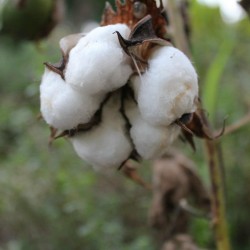
Cotton Seeds (Gossypium...
السعر
2.35 €
(SKU: T 10)
Seeds Gallery EU,
5/
5
<h2><strong>Cotton Seeds (Gossypium Herbaceum)</strong></h2>
<h2><span style="color: #ff0000;"><strong>Price for Package of 10 or 15 seeds.</strong></span></h2>
<p>Gossypium herbaceum is one of the cultivated cotton species. This short-lived and fast-growing perennial shrub can grow up to about 5 ft (1.5 m) tall. It has trilobed or palmate leaves and yellow hibiscus-like flowers. It produces capsules that split open when ripe and that display a loose tuft of white filaments, that constitute the cotton.</p>
<p>This plant likes a long, hot growing season to correctly grow and produce good fibers. Moreover, it is very cold tender and should be grown in frost-free climates. Elsewhere, it can be grown as an annual plant.</p>
<p><strong>WIKIPEDIA:</strong></p>
<p><i><b>Gossypium herbaceum</b></i>, commonly known as <b>Levant cotton</b>, <sup id="cite_ref-BSBI07_1-0" class="reference"></sup>is a species of cotton native to the semi-arid regions of sub-Saharan Africa and Arabia where it still grows in the wild as a perennial shrub.<span style="font-size: 11.6667px;"> </span>It is a sister-species of <i>Gossypium arboreum</i>.</p>
<h2><span class="mw-headline" id="Description">Description</span></h2>
<p><i>G. herbaceum</i><span> </span>has high<span> </span>stems<span> </span>that grow 2 feet (0.61 m) to 6 feet (1.8 m) high with wide, hairy leaves. Their<span> </span>flowers<span> </span>are small and yellow with a purple center. The plant exhibits<span> </span>extrafloral nectaries<span> </span>(calyculal nectaria, found on the receptacle, near the base of the<span> </span>calyculus).</p>
<p>When ripe and in warm weather, the flower capsule will burst and expose the cotton surrounding the<span> </span>seeds<span> </span>firmly. The cotton produced by this plant is short, about 2 inches (5.1 cm) long and is firmly attached to the seed, which is covered in hairy down. An<span> </span>acre<span> </span>of cotton can be expected to produce about 300 pounds (140 kg).</p>
<h2><span class="mw-headline" id="Uses">Uses</span></h2>
<p>Cotton fibers grow from the surface of the seeds and can be separated from these by hand or mechanically; the long fibers are called lint. The cotton fibers are constituted of nearly pure<span> </span>cellulose. The main use of cotton lint is as<span> a </span>textile<span> </span>for clothing. The fibers are spun into<span> </span>yarns<span> </span>and these are woven into<span> </span>fabrics, in the farm or house or in factories. Cotton as a fabric is much appreciated because of its comfortable, breathable properties, its resistance and also because it is easily stained.</p>
<p>The cotton plant itself has medicinal uses and can be cultivated traditionally, in house backyards, for, e.g., women's<span> </span>menstrual cycle<span> </span>pains and irregular bleeding. It is also known to be used after birth to expel the<span> </span>placenta<span> </span>and to increase the<span> </span>lactation, as well as for<span> </span>gastrointestinal issues, such as<span> </span>hemorrhages<span> </span>and<span> </span>diarrhea, for<span> </span>nausea,<span> </span>fevers,<span> </span>and<span> </span>headaches.</p>
<p>In the<span> </span>Levant<span> </span>seeds of<span> </span><i>Gossypium herbaceum</i><span> </span>were also used for food, feed or oil extraction. Cotton seeds, containing up to 20% oil and 20% proteins, are potentially highly rich as food or feed. Nevertheless, small glands present in all the plant organs of the<span> </span><i>Gossypium</i><span> </span>species, except the roots, and especially abundant in the seeds, contain toxic chemicals, in particular, the<span> </span>polyphenolic<span> </span>compound<span> </span>Gossypol. The gossypol is highly toxic to animals and is an element of the plant's direct defense system against herbivorous arthropods. It can cause severe growth and development disorders in humans as well as domestic animals, particularly monogastric animals, while polygastrics are more or less tolerant. For this reason, using oil or whole seeds for human nutrition is dependent upon some way of elimination of the gossypol, through heating or other treatment. The gossypol extracted from cotton seeds has potential use as a<span> </span>male contraceptive<span> </span>but can cause irreversible<span> </span>infertility<span> </span>after repeated use. In<span> </span>lab rat<span> </span>studies, it has been able to<span> </span>stop<span> </span>early<span> </span>pregnancies.</p>
T 10 (10 S)


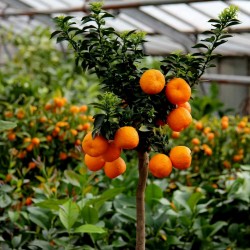
CHINOTTO - Myrtle Leaved...
السعر
6.00 €
(SKU: V 145)
Seeds Gallery EU,
5/
5
<h2><strong>CHINOTTO - Myrtle Leaved Orange Tree Seeds</strong></h2>
<h2><span style="color: #ff0000;"><strong>Price for Package of 3 seeds.</strong></span></h2>
<p>Citrus myrtifolia, the myrtle-leaved orange tree, is a species of Citrus with foliage similar to that of the common myrtle. It is a compact tree with small leaves and no thorns which grows to a height of three metres and can be found in Malta, Libya and in the Liguria, Tuscany, Sicily, and Calabria regions of Italy.</p>
<p>The fruit of the tree resemble small oranges. They are sour or bitter and are commonly called by their Italian name, chinotto. They are an essential flavoring agent of most Italian amari, of the popular Campari aperitif, and of several brands of carbonated soft drinks that are generically called "chinotto".</p>
<p><strong>Citrus myrtifolia is sometimes planted in gardens. Due to its compactness, it can also be planted in a pot or other container.</strong></p>
V 145


نبات مقاوم للبرد والصقيع
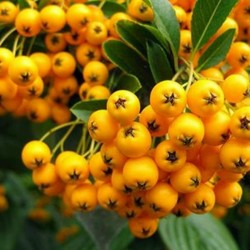
شوك النار القرمزي بذور
السعر
1.50 €
(SKU: T 19)
Seeds Gallery EU,
5/
5
<meta http-equiv="Content-Type" content="text/html; charset=UTF-8" />
<h2><strong>شوك النار القرمزي بذور</strong></h2>
<h2><span style="color: #ff0000;"><strong>ثمن عبوة من 20 بذرة.</strong></span></h2>
<p><span>شوك النار القرمزي (الاسم العلمي: Pyracantha coccinea) هو نوع من النباتات يتبع جنس شوك النار من الفصيلة الوردية.</span></p>
<p><span>Scarlet Firethorn is a large, fast growing, semi-evergreen to evergreen shrub that is cherished for its spectacular fall and winter display of scarlet fruits and ability to withstand difficult conditions. Shooting long limber stems in all directions, an untrained Firethorn, typically grows into a tangled mound up to 18 feet in height and 12 feet wide. It is armed with sharp thorns that hide among the dark, glossy green leaves. Abundant clusters (corymbs) of small white flowers appear in spring. The flower clusters are up to 2 inches across and are borne close together creating the appearance of nearly solid surface of flowers. In fall the 1/4 inch berries begin to ripen, their color mellowing from green to shades of red and orange. These persist through winter and into early spring depending on climate and appetite of the local bird population. The prolific flowers are lovely to behold and have some fragrance (although not all would agree that it is appealing). Birds, especially cedar waxwings, like the plump, colorful berries. The brilliant berry-laden branches of Firethorn hold up extremely well in cut arrangements and add interest and color to wreaths.</span></p>
<p>Firethorn is often used as an espalier. Held flat against a wall, it can be shaped quite creatively. Landscapers love the firethorns for their fast rate of growth and ability to withstand drought and neglect. The shrubs ruggedness and disease and pest resistance makes this plant a very popular item in commercial landscapes. The wide-reaching stems may be pruned back as needed during warm weather as the shrub blooms on old wood. Consider using it as a formal or informal hedge. This will require some trimming and shaping for the first few years but the effort will produce impressively beautiful and secure (thorny) hedges.</p>
<p>Leaf: Alternate, simple, oblong to lanceolate, serrated margin, 1 to 2 inches long, semi-evergreen to evergreen, shiny, dark green above, paler and pubescent below. </p>
<p>Flower: Creamy white, 5 petals, 1/3 inch across in tight clusters several inches across, appearing in late spring to early summer.</p>
<p>Fruit: Small pome, 1/4 inch across, bright orange-red, occurring in tight clusters, very showy, ripens in late summer and persists through the winter. </p>
<p>Twig: Slender, initially pubescent, later glaborous, red-brown, numerous spines, small buds. </p>
<p>Bark: Smooth reddish brown with numerous lenticels. </p>
<p>Form: Upright, open shrub with stiff limbs and thorns, can reach 18 feet tall. </p>
<p>Other Names: Scarlet Firethorn</p>
<p>Zone: 5 to 9 In moderate to severe zone 5 winters, the bronzed broadleaf evergreen foliage will severely "burn" or die, and stem dieback may occur anywhere from tip dieback all the way to the snowline.</p>
<p>Growth Rate: Fast to Moderate</p>
<p>Plant Type: Semi-evergreen to evergreen shrub</p>
<p>Family: Rosaceae</p>
<p>Native Range: Europe, Southwestern Asia</p>
<p>Height: 10 to 18 feet</p>
<p>Spread: 10 to 18 feet</p>
<p>Shape: Variable from upright and spreading to arching and irregular. Can become open without pruning.</p>
<p>Bloom Time: May</p>
<p>Bloom Color: White</p>
<p>Sun: Sun to Part Shade</p>
<p>Fall Color: Bronze to Evergreen</p>
<p>Drought Tolerance: Moderate to High (once established)</p>
<p>Water: Medium</p>
<p>Maintenance: Low to Moderate</p>
<p>Site Requirements/Soil Tolerances: Prefers moist, well-drained soils in full sun, but is very urban tolerant and adaptable to poor soils, compacted soils, soils of various pH, heat, drought, and heavy pruning. Will grow in partial to fairly heavy shade, however, flowering and fruiting will not be as heavy.</p>
<p>Culture: Difficult to prune because of thorns. Best time to prune vigorously growing specimens or espaliers is either right after bloom (to set up flower buds and fruits for the following year) or in autumn or early spring (to gain firm control with heavy pruning, and forego flowering and fruiting for an entire year).</p>
<p>Uses: Hedge/Screen, Espalier, Trellis, Bonsai, Crafts.</p>
<p>Hardy, Adaptable, Easy to Grow, Fast Growth, Attracts Birds, Wildlife Food/Shelter, Showy Flowers/Fruit, Hedge/Screen, Espalier, Trellis, Bonsai, Cold, Heat, Drought, Urban and Wind Tolerant</p>
<table>
<tbody>
<tr>
<td>
<p><span><strong>Sowing Instructions</strong></span></p>
</td>
</tr>
<tr>
<td nowrap="nowrap">
<p><span><strong>Propagation:</strong></span></p>
</td>
<td>
<p><span>Seeds</span></p>
</td>
</tr>
<tr>
<td nowrap="nowrap">
<p><span><strong>Pretreat:</strong></span></p>
</td>
<td>
<p><span>soak in water for 24 hours</span></p>
</td>
</tr>
<tr>
<td nowrap="nowrap">
<p><span><strong>Stratification:</strong></span></p>
</td>
<td>
<p><span>3-4 months in moist sowing mix at 2-5 ° C refrigerator</span></p>
</td>
</tr>
<tr>
<td nowrap="nowrap">
<p><span><strong>Sowing Time:</strong></span></p>
</td>
<td>
<p><span>all year round</span></p>
</td>
</tr>
<tr>
<td nowrap="nowrap">
<p><span><strong>Sowing Depth:</strong></span></p>
</td>
<td>
<p><span>3,2 mm - 1/8” (Cover lightly with substrate)</span></p>
</td>
</tr>
<tr>
<td nowrap="nowrap">
<p><span><strong>Sowing Mix:</strong></span></p>
</td>
<td>
<p><span>Coir or sowing mix + sand or perlite</span></p>
</td>
</tr>
<tr>
<td nowrap="nowrap">
<p><span><strong>Germination temperature:</strong></span></p>
</td>
<td>
<p><span>min. 18° C</span></p>
</td>
</tr>
<tr>
<td nowrap="nowrap">
<p><span><strong>Location:</strong></span></p>
</td>
<td>
<p><span>bright + keep constantly moist not wet</span></p>
</td>
</tr>
<tr>
<td nowrap="nowrap">
<p><span><strong>Germination Time:</strong></span></p>
</td>
<td>
<p><span>until it germinates </span></p>
</td>
</tr>
<tr>
<td nowrap="nowrap">
<p><span><strong>Watering:</strong></span></p>
</td>
<td>
<p><span>Water regularly during the growing season</span></p>
</td>
</tr>
<tr>
<td nowrap="nowrap">
<p><span><strong> </strong></span></p>
</td>
<td>
<p><br /><span><em>Copyright © 2012 Seeds Gallery - Saatgut Galerie - Galerija semena. </em><em>All Rights Reserved.</em></span></p>
</td>
</tr>
</tbody>
</table>
T 19 Y

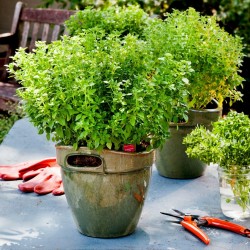
Bush or Greek Basil Seeds...
السعر
1.95 €
(SKU: MHS 26)
Seeds Gallery EU,
5/
5
<meta http-equiv="Content-Type" content="text/html; charset=UTF-8" />
<h2><strong>Bush or Greek Basil Seeds (Ocimum basilicum)</strong></h2>
<h2><span style="color: #ff0000;"><strong>Price for Package of 100 Seeds.</strong></span></h2>
<p><strong>Bush or Greek basil:<span> </span></strong>Has a strong aroma but mild flavor, so it can be substituted for sweet basil. Forms a compact bush with small leaves and grows well in a pot.</p>
<p><b>Basil</b><span> </span>(<span class="nowrap"><small>UK:<span> </span></small><span class="IPA nopopups noexcerpt">/<span><span title="/ˈ/: primary stress follows">ˈ</span><span title="'b' in 'buy'">b</span><span title="/æ/: 'a' in 'bad'">æ</span><span title="'z' in 'zoom'">z</span><span title="/əl/: 'le' in 'bottle'">əl</span></span>/</span></span>,<sup id="cite_ref-Collins_1-0" class="reference">[1]</sup><span> </span><span class="nowrap"><small>US:<span> </span></small><span class="IPA nopopups noexcerpt">/<span><span title="/ˈ/: primary stress follows">ˈ</span><span title="'b' in 'buy'">b</span><span title="/eɪ/: 'a' in 'face'">eɪ</span><span title="'z' in 'zoom'">z</span><span title="/əl/: 'le' in 'bottle'">əl</span></span>/</span></span>;<sup id="cite_ref-Collins2_2-0" class="reference">[2]</sup><span> </span><i>Ocimum basilicum</i>), also called<span> </span><b>great basil</b><span> </span>or<span> </span><b>Saint-Joseph's-wort</b>, is a<span> </span>culinary herb<span> </span>of the<span> </span>family<span> </span>Lamiaceae<span> </span>(mints).</p>
<p>Basil is native to tropical regions from central Africa to<span> </span>Southeast Asia.<sup id="cite_ref-simon_3-0" class="reference">[3]</sup><span> </span>It is a<span> </span>tender<span> </span>plant, and is used in<span> </span>cuisines<span> </span>worldwide. Depending on the species and cultivar, the leaves may taste somewhat like<span> </span>anise, with a strong, pungent, often sweet smell.</p>
<p>There are many<span> </span>varieties of basil, as well as several related species or hybrids also called basil. The type used commonly as a flavor is typically called<span> </span><b>sweet basil</b><span> </span>(or<span> </span><b>Genovese basil</b>), as opposed to<span> </span>Thai basil<span> </span>(<i>O. basilicum</i><span> </span>var.<span> </span><i>thyrsiflora</i>),<span> </span>lemon basil<span> </span>(<i>O. × citriodorum</i>), and<span> </span>holy basil<span> </span>(<i>Ocimum tenuiflorum</i>). While most common varieties of basil are treated as<span> </span>annuals, some are<span> </span>perennial<span> </span>in warm, tropical climates, including holy basil and a cultivar known as "African blue basil".</p>
<h2><span class="mw-headline" id="Description">Description</span></h2>
<p>Basil is an<span> </span>annual, or sometimes<span> </span>perennial, herb used for its leaves. Depending on the variety, plants can reach between 30 cm (0.98 ft) and 150 cm (4.9 ft). Its leaves are richly green and ovate, but otherwise come in a wide variety of sizes and shapes depending on cultivar. Leaf sizes range from 3 cm (1.2 in) to 11 cm (4.3 in) long, and between 1 cm (0.39 in) and 6 cm (2.4 in) wide. Basil grows a thick, central<span> </span>taproot. Its flowers are small and white, and grow from a central inflorescence that emerges from the central stem atop the plant.<sup class="noprint Inline-Template Template-Fact">[<i><span title="This claim needs references to reliable sources. (April 2019)">citation needed</span></i>]</sup></p>
<h3><span class="mw-headline" id="Phytochemistry">Phytochemistry</span></h3>
<p>The various basils have such different scents because the herb has a number of different<span> </span>essential oils<span> </span>in different proportions for various cultivars.<sup id="cite_ref-simon_3-1" class="reference">[3]</sup><span> </span>The essential oil from European basil contains high concentrations of<span> </span>linalool<span> </span>and<span> </span>methyl chavicol<span> </span>(estragole), in a ratio of about 3:1.<sup id="cite_ref-simon_3-2" class="reference">[3]</sup><sup id="cite_ref-janick_4-0" class="reference">[4]</sup><span> </span>Other constituents include:<span> </span>1,8-cineole,<span> </span>eugenol, and<span> </span>myrcene, among others.<sup id="cite_ref-simon_3-3" class="reference">[3]</sup><sup id="cite_ref-Breitmaier2006_5-0" class="reference">[5]</sup><span> </span>The<span> </span>clove<span> </span>scent of sweet basil is derived from<span> </span>eugenol.<sup id="cite_ref-Islam2011_6-0" class="reference">[6]</sup><span> </span>The aroma profile of basil includes<span> </span>1,8-cineole<sup id="cite_ref-suie_7-0" class="reference">[7]</sup><sup id="cite_ref-edsh_8-0" class="reference">[8]</sup><span> </span>and<span> </span>methyl eugenol.<sup id="cite_ref-suie_7-1" class="reference">[7]</sup><sup id="cite_ref-mobg_9-0" class="reference">[9]</sup></p>
<h2><span class="mw-headline" id="Taxonomy">Taxonomy</span></h2>
<div class="hatnote navigation-not-searchable">Further information:<span> </span>List of basil cultivars</div>
<p>The exact taxonomy of basil is uncertain due to the immense number of cultivars, its ready polymorphy, and frequent cross-pollination (resulting in new hybrids) with other members of the genus<span> </span><i>Ocimum</i><span> </span>and within the species.<span> </span><i>Ocimum basilicum</i><span> </span>has at least 60 varieties, which further complicates taxonomy.<sup id="cite_ref-simon_3-4" class="reference">[3]</sup></p>
<p>Most basils are cultivars of sweet basil.</p>
<ul>
<li>Anise basil,<span> </span>Licorice basil<span> </span>or<span> </span>Persian basil<span> </span>(<i>O. basilicum</i><span> </span>'Licorice')</li>
<li>Cinnamon basil<span> </span>(<i>Ocimum basilicum</i><span> </span>'Cinnamon')</li>
<li>Dark opal basil<span> </span>(<i>Ocimum basilicum</i><span> </span>'Dark Opal')</li>
<li>Lettuce leaf basil<span> </span>(<i>Ocimum basilicum</i><span> </span>'Crispum')</li>
<li>Purple basil (<i>Ocimum basilicum</i><span> </span>'Purpurescens')</li>
<li>Rubin basil<span> </span>(<i>Ocimum basilicum</i><span> </span>'Rubin')</li>
<li>Globe basil, dwarf basil, French basil (<i>Ocimum basilicum</i><span> </span>'Minimum'<sup id="cite_ref-10" class="reference">[10]</sup>)</li>
<li>Thai basil<span> </span>(<i>Ocimum basilicum thyrsifolium</i>)</li>
</ul>
<h3><span class="mw-headline" id="Hybrids">Hybrids</span></h3>
<ul>
<li>African blue basil<span> </span>(<i>Ocimum basilicum X O. kilimandscharicum</i>)</li>
<li>Spice basil (<i>Ocimum basilicum X O. americanum</i>), which is sometimes sold as holy basil)</li>
<li>Lemon basil<span> </span>(<i>Ocimum basilicum X O. americanum</i><sup id="cite_ref-11" class="reference">[11]</sup><sup id="cite_ref-12" class="reference">[12]</sup>)</li>
</ul>
<h3><span class="mw-headline" id="Similar_species">Similar species</span></h3>
<ul>
<li>Camphor basil, African basil (<i>O. kilimandscharicum</i>)</li>
<li>Clove basil, also African basil (<i>Ocimum gratissimum</i><sup id="cite_ref-tgte_13-0" class="reference">[13]</sup><sup id="cite_ref-aaeo_14-0" class="reference">[14]</sup>)</li>
<li>Holy basil<span> </span>(<i>Ocimum tenuiflorum</i>, formerly known as<span> </span><i>O. sanctum</i>)</li>
</ul>
<h3><span class="mw-headline" id="Other_cultivars">Other cultivars</span></h3>
<p>Several other basils, including some other<span> </span><i>Ocimum</i><span> </span>species, are grown in many regions of Asia. Most of the Asian basils have a<span> </span>clove-like flavor that is, in general, stronger than the Mediterranean basils. The most notable is the holy basil or<span> </span>tulsi, a revered home-grown plant in India and<span> </span>Nepal.</p>
<p>Lemon basil has a strong<span> </span>lemony<span> </span>smell and flavor very different from those of other varieties because it contains a chemical called<span> </span>citral. It is widely used in<span> </span>Indonesia, where it is called<span> </span><i>kemangi</i>, served raw together with raw<span> </span>cabbage,<span> </span>green beans, and<span> </span>cucumber<span> </span>as an accompaniment to fried fish or duck. Its flowers, when broken up, are a zesty<span> </span>saladcondiment.</p>
<h3><span class="mw-headline" id="Etymology">Etymology</span></h3>
<p>The name "basil" comes from Latin,<span> </span><i>basilius</i>, and Greek βασιλικόν φυτόν (<i>basilikón phutón</i>), "royal/kingly plant", possibly because the plant was believed to have been used in production of royal perfumes.<sup id="cite_ref-eo_15-0" class="reference">[15]</sup><span> </span>The Latin name has been confused with<span> </span>basilisk, as it was supposed to be an<span> </span>antidote<span> </span>to the basilisk's venom.<sup id="cite_ref-eo_15-1" class="reference">[15]</sup></p>
<h2><span class="mw-headline" id="Distribution_and_habitat">Distribution and habitat</span></h2>
<p>Basil is native to India and other tropical regions stretching from Africa to Southeast Asia, but has now become globalized due to human cultivation.<sup id="cite_ref-simon_3-5" class="reference">[3]</sup></p>
<h2><span class="mw-headline" id="Cultivation">Cultivation</span></h2>
<p>Most culinary and ornamental basils are cultivars of the species<span> </span><i>Ocimum basilicum</i>, but other species are also grown and there are many hybrids between species. Traditionally a green plant, some varieties, such as 'Purple Delight' have leaves that appear purple. Basil grows between 30–130 cm (12–51 in) tall, with opposite, light green, silky<span> </span>leaves<span> </span>3–11 cm (1.2–4.3 in) long and 1–6 cm (0.39–2.36 in) broad. The flowers are small, white in color and arranged in a terminal<span> </span>spike. Unusual among Lamiaceae, the four<span> </span>stamens<span> </span>and the<span> </span>pistil<span> </span>are not pushed under the upper lip of the<span> </span>corolla, but lie over the inferior lip. After<span> </span>entomophilous<span> </span>pollination, the corolla falls off and four round<span> </span>achenes<span> </span>develop inside the bilabiate<span> </span>calyx.</p>
<p>Basil is sensitive to cold, with best growth in hot, dry conditions. It behaves as an annual if there is any chance of a frost. However, due to its popularity, basil is cultivated in many countries around the world. Production areas include countries in the Mediterranean area, those in the<span> </span>temperate zone, and others in<span> </span>subtropical<span> </span>climates.<sup id="cite_ref-16" class="reference">[16]</sup></p>
<p>In Northern Europe, Canada, the northern states of the U.S., and the South Island of New Zealand it will grow best if sown under glass in a<span> </span>peat<span> </span>pot, then planted out in late spring/early summer (when there is little chance of a frost). Additionally, it may be sown in soil once chance of frost is past. It fares best in well-drained, sunny exposure.</p>
<p>Although basil grows best outdoors, it can be grown indoors in a pot and, like most herbs, will do best on a sun-facing windowsill. It should be kept away from extremely cold drafts, and grows best in strong sunlight, therefore a<span> </span>greenhouse<span> </span>or<span> </span>row cover<span> </span>is ideal if available. It can, however, be grown even in a basement, under fluorescent lights.</p>
<p>If its leaves have wilted from lack of water, it will recover if watered thoroughly and placed in a sunny location. Yellow leaves towards the bottom of the plant are an indication that the plant has been stressed; usually this means that it needs less water, or less or more fertilizer.</p>
<p>In sunnier climates such as Southern Europe, the southern states of the U.S., the North Island of New Zealand, and Australia, basil will thrive when planted outside. It also thrives over the summertime in the central and northern United States, but dies out when temperatures reach freezing point. It will grow back the next year if allowed to go to seed. It will need regular watering, but not as much attention as is needed in other climates.</p>
<p>Basil can also be propagated reliably from cuttings with the stems of short cuttings suspended for two weeks or so in water until roots develop.</p>
<p>Once a stem produces flowers, foliage production stops on that stem, the stem becomes woody, and essential oil production declines. To prevent this, a basil-grower may pinch off any flower stems before they are fully mature. Because only the blooming stem is so affected, some stems can be pinched for leaf production, while others are left to bloom for decoration or seeds.</p>
<p>Once the plant is allowed to flower, it may produce seed pods containing small black seeds, which can be saved and planted the following year. Picking the leaves off the plant helps promote growth, largely because the plant responds by converting pairs of leaflets next to the topmost leaves into new stems.</p>
<p>Basil is popularly recommended as a<span> </span>companion plant<span> </span>to the<span> </span>tomato. Common claims are that basil may deter pests or improve tomato flavor. However, in double-blind taste tests, basil did not significantly affect the taste of tomatoes when planted adjacent to them.<sup id="cite_ref-18" class="reference"></sup></p>
<h3><span class="mw-headline" id="Diseases">Diseases</span></h3>
<p>Basil suffers from several plant pathogens that can ruin the crop and reduce<span> </span>yield.<span> </span>Fusarium wilt<span> </span>is a soil-borne fungal disease that will quickly kill younger basil plants.<span> </span>Seedlings<span> </span>may be killed by<span> </span><i>Pythium</i><span> </span>damping off. A common<span> </span>foliar<span> </span>disease of basil is<span> </span>gray mold<span> </span>caused by<span> </span><i>Botrytis cinerea</i>; it can cause infections post-harvest and is capable of killing the entire plant.<span> </span>Black spot<span> </span>can be seen on basil foliage and is caused by the<span> </span>fungigenus<span> </span><i>Colletotrichum</i>.<span> </span>Downy mildew<span> </span>caused by<span> </span><i>Peronospora belbahrii</i><span> </span>is a significant disease, as first reported in Italy in 2004.<sup id="cite_ref-19" class="reference">[19]</sup><span> </span>It was reported in the U.S. in 2007 and 2008.<sup id="cite_ref-21" class="reference"></sup></p>
<p>Non-pathogenic bacteria found on basil include<span> </span><i>Novosphingobium</i><span> </span>species.</p>
<h2><span class="mw-headline" id="Uses">Uses</span></h2>
<div class="thumb tleft">
<div class="thumbinner"><img alt="" src="https://upload.wikimedia.org/wikipedia/commons/thumb/7/72/Basilic-spice.jpg/200px-Basilic-spice.jpg" width="200" height="126" class="thumbimage" />
<div class="thumbcaption">
<div class="magnify"></div>
Dried basil leaves</div>
</div>
</div>
<h3><span class="mw-headline" id="Culinary">Culinary</span></h3>
<p>Basil is most commonly used fresh in recipes. In general, it is added at the last moment, as cooking quickly destroys the flavor. The fresh herb can be kept for a short time in plastic bags in the refrigerator, or for a longer period in the freezer, after being<span> </span>blanched<span> </span>quickly in boiling water. The dried herb also loses most of its flavor, and what little flavor remains tastes very different, with a weak<span> </span>coumarin<span> </span>flavor, like<span> </span>hay.<sup class="noprint Inline-Template Template-Fact">[<i><span title="This claim needs references to reliable sources. (July 2018)">citation needed</span></i>]</sup></p>
<p>Basil is one of the main ingredients in<span> </span>pesto—a green Italian oil-and-herb sauce.</p>
<p>The most commonly used Mediterranean basil<span> </span>cultivars<span> </span>are "Genovese", "Purple Ruffles", "Mammoth", "Cinnamon", "Lemon", "Globe", and "African Blue". The<span> </span>Chinese<span> </span>also use fresh or dried basils in soups and other foods. In<span> </span>Taiwan, people add fresh basil leaves to thick soups. They also eat<span> </span>fried chicken<span> </span>with deep-fried basil leaves. Basil (most commonly Thai basil) is commonly steeped in cream or milk to create an interesting flavor in ice cream or chocolates (such as truffles). The leaves are not the only part of basil used in culinary applications, the flower buds have a more subtle flavor and they are edible.</p>
<h4><span class="mw-headline" id="Seeds">Seeds</span></h4>
<p>When soaked in water, the seeds of several basil varieties become gelatinous, and are used in Asian drinks and desserts such as<span> </span><i>faluda</i>,<span> </span><i>sharbat-e-rihan</i>, or<span> </span><i>hột é</i>.</p>
<p>Research studies of the essential oil showed antifungal and insect-repelling properties,<sup id="cite_ref-apia_23-0" class="reference">[23]</sup><span> </span>including potential toxicity to<span> </span>mosquitos.<sup id="cite_ref-etdp_24-0" class="reference">[24]</sup></p>
<h3><span class="mw-headline" id="Folk_medicine">Folk medicine</span></h3>
<p>In<span> </span>folk medicine<span> </span>practices, such as those of<span> </span>Ayurveda<span> </span>or<span> </span>traditional Chinese medicine, basil is thought to have therapeutic properties.<sup id="cite_ref-25" class="reference">[25]</sup><sup id="cite_ref-:1_26-0" class="reference">[26]</sup></p>
<h2><span class="mw-headline" id="Culture">Culture</span></h2>
<p>There are many rituals and beliefs associated with basil. The French sometimes call basil "<i>l'herbe royale</i>" ("royal herb"),<sup id="cite_ref-CarrollVona2006_27-0" class="reference">[27]</sup><span> </span>while Jewish folklore suggests it adds strength while fasting.<sup id="cite_ref-Navarra2004_28-0" class="reference">[28]</sup><span> </span>In<span> </span>Portugal, dwarf bush basil is traditionally presented in a pot, together with a poem and a paper<span> </span>carnation, to a sweetheart, on the religious holidays of Saint John and Saint Anthony. However, basil represented hatred in ancient<span> </span>Greece, and European lore sometimes claims that basil is a symbol of<span> </span>Satan.<sup id="cite_ref-Arrowsmith2009_29-0" class="reference">[29]</sup></p>
<p>Holy basil, also called<span> </span>tulsi, is highly revered in<span> </span>Hinduism.</p>
<p>Basil has religious significance in the<span> </span>Greek Orthodox Church, where it is used to sprinkle holy water.<sup id="cite_ref-blessing-of-the-waters_30-0" class="reference">[30]</sup><span> </span>The<span> </span>Bulgarian Orthodox Church,<span> </span>Serbian Orthodox Church,<span> </span>Macedonian Orthodox Church<span> </span>and<span> </span>Romanian Orthodox Church<span> </span>use basil (Bulgarian and Macedonian:<span> </span><i>босилек</i>;<span> </span>Romanian:<span> </span><i>busuioc</i>,<span> </span>Serbian:<span> </span><span lang="sr" xml:lang="sr">босиљак</span>) to prepare holy water and pots of basil are often placed below church altars.<sup id="cite_ref-MacDermott1998_31-0" class="reference">[31]</sup></p>
<p>In Europe, basil is placed in the hands of the dead to ensure a safe journey.<sup id="cite_ref-CEPC2007_32-0" class="reference">[32]</sup><span> </span>In India, they place it in the mouth of the dying to ensure they reach God.<sup id="cite_ref-Bregman2010_33-0" class="reference">[33]</sup><span> </span>The ancient Egyptians and ancient Greeks believed it would open the gates of heaven for a person passing on.<sup id="cite_ref-Nelson-Shellenbarger2013_34-0" class="reference">[34]</sup></p>
<table cellspacing="0" cellpadding="0" border="1">
<tbody>
<tr>
<td colspan="2" width="100%" valign="top">
<p><span style="color: #008000;"><strong>Sowing Instructions</strong></span></p>
</td>
</tr>
<tr>
<td valign="top" nowrap="nowrap">
<p><span style="color: #008000;"><strong>Propagation:</strong></span></p>
</td>
<td valign="top">
<p><span style="color: #008000;">Seeds</span></p>
</td>
</tr>
<tr>
<td valign="top" nowrap="nowrap">
<p><span style="color: #008000;"><strong>Pretreat:</strong></span></p>
</td>
<td valign="top">
<p><span style="color: #008000;">0</span></p>
</td>
</tr>
<tr>
<td valign="top" nowrap="nowrap">
<p><span style="color: #008000;"><strong>Stratification:</strong></span></p>
</td>
<td valign="top">
<p><span style="color: #008000;">0</span></p>
</td>
</tr>
<tr>
<td valign="top" nowrap="nowrap">
<p><span style="color: #008000;"><strong>Sowing Time:</strong></span></p>
</td>
<td valign="top">
<p><span style="color: #008000;">all year round</span></p>
</td>
</tr>
<tr>
<td valign="top" nowrap="nowrap">
<p><span style="color: #008000;"><strong>Sowing Depth:</strong></span></p>
</td>
<td valign="top">
<p><span style="color: #008000;">Needs Light to germinate! Just sprinkle on the surface of the substrate + gently press</span></p>
</td>
</tr>
<tr>
<td valign="top" nowrap="nowrap">
<p><span style="color: #008000;"><strong>Sowing Mix:</strong></span></p>
</td>
<td valign="top">
<p><span style="color: #008000;">Coir or sowing mix + sand or perlite</span></p>
</td>
</tr>
<tr>
<td valign="top" nowrap="nowrap">
<p><span style="color: #008000;"><strong>Germination temperature:</strong></span></p>
</td>
<td valign="top">
<p><span style="color: #008000;">18-20 ° C</span></p>
</td>
</tr>
<tr>
<td valign="top" nowrap="nowrap">
<p><span style="color: #008000;"><strong>Location:</strong></span></p>
</td>
<td valign="top">
<p><span style="color: #008000;">bright + keep constantly moist not wet</span></p>
</td>
</tr>
<tr>
<td valign="top" nowrap="nowrap">
<p><span style="color: #008000;"><strong>Germination Time:</strong></span></p>
</td>
<td valign="top">
<p><span style="color: #008000;">1-2 weeks</span></p>
</td>
</tr>
<tr>
<td valign="top" nowrap="nowrap">
<p><span style="color: #008000;"><strong>Watering:</strong></span></p>
</td>
<td valign="top">
<p><span style="color: #008000;">Water regularly during the growing season</span></p>
</td>
</tr>
<tr>
<td valign="top" nowrap="nowrap">
<p><span style="color: #008000;"><strong> </strong></span></p>
</td>
<td valign="top">
<p><br /><span style="color: #008000;"><em>Copyright © 2012 Seeds Gallery - Saatgut Galerie - Galerija semena. </em><em>All Rights Reserved.</em></span></p>
</td>
</tr>
</tbody>
</table>
MHS 26 (100 S)

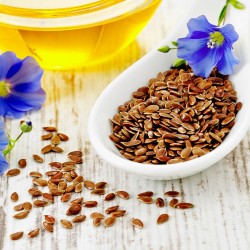
كتان بذور
السعر
1.35 €
(SKU: VE 215)
Seeds Gallery EU,
5/
5
<h2 dir="rtl"><strong>كتان بذور</strong></h2>
<h2 dir="rtl"><span style="color: #ff0000;" class=""><strong>ثمن عبوة 120 (1g) بذرة.</strong></span></h2>
<p>الكتان (بالإنجليزية: Flax)، والمعروف أيضا باسم بذر الكتان (بالإنجليزية: linseed)، (الاسم العلمي: Linum usitatissimum) نبات حولي من المحاصيل الزيتية ينتمي للفصيلة الكتانية. الموطن الأصلي للكتان يمتد من شرق البحر المتوسط إلى الهند ويعتقد أن بداية استخدامه تمت في منطقة الهلال الخصيب.</p>
<p>الكتان هو نبات حولي أو معمر وينتمي للفصيلة الكتانية، والأجزاء المستخدمة في نبات الكتان هو الزيت والبذور. يصل ارتفاع نبات الكتان إلى حوالي متر وله ساق نحيلة وأوراق، وتتميز زهوره باللون الأزرق، أما البذور فلونها بني. يزرع الكتان في شرق البحر المتوسط إلى الهند ويزرع أيضاً في أوروبا.</p>
<p>الاستعمال<br>يزرع الكتان لبذوره. كما قد تستعمل أقسام من نبتة الكتان في عدة صناعات منها القماش، الحبر، الورق، شباك الصيد، الصابون ومثبتات الشعر. كما قد تستعمل النبتة للزينة في الحدائق.</p>
<p>الوصف النباتي<br>النبات قائم، يصل ارتفاعه إلى حوالي المتر، ذو ساق نحيلة وأوراقه رمحية وأزهاره زرقاء، عرف وزرع في مصر القديمة منذ عهد الفراعنة، وصنع منه قماش عرف بقماش الكتان الذي استخدم في التحنيط.</p>
<p>أما بذوره فهي زيتية بها 40% من الزيت به نسبة عالية من أوميجا 3 و22% بروتينات و4% معادن. وزيت الكتان (الحار) به نسبة عالية من (أوميجا 3) الذي يفيد في تقليل الكولسترول. والزيت له رائحة مميزة تزيد مع التخزين. والبذور مقارنة بالزيت، نجدها تحتوي على نسبة 98% من مادة ليجنام lignans المضادة للسرطان و97% أكثر من الألياف وأوميجا 3، وهذه المواد تفيد في تقليل الكولسترول وأعراض ما قبل الدورة والإقلال من الوزن ومرض السكر، وكذلك تعالج أمراض الكبد وذلك بأخذ ملعقة في الصباح كل يوم ولمدة شهر كامل.</p>
<p>ويدخل زيت الكتان في صناعة الأقمشة وصناعة الأصباغ.</p>
<p>يشجع البعض على استخدام بذور الكتان كمليّن بسبب محتواه من الألياف الغذائية، ويحتوي على أستروجين طبيعي مهم جداً للمرأة خاصة في فترة ما بعد انقطاع الطمث لتجنب أعراض نقص الأستروجين بعد سن اليأس. لكن الإفراط في استهلاكه من دون سوائل يمكن أن يؤدّي إلى انسداد في الأمعاء. إن استهلاك كميات كبيرة من بذور الكتان قد يضعف من فعالية بعض الأدوية بسبب كميّة الألياف الموجودة فيه كما يجب تناول بذور الكتان الناضجة فقط. من المهم جداً أن تستخدم بذور الكتان باعتدال وعدم تناولها بإفراط نظراً لمفعولها المسهّل الشديد، ومن المستحسن سحق البذور قبل استعمالها بقليل وذلك تجنّباً لتأكسدها.</p>
<p>وكذلك لا ينصح بتناول بذور الكتان وزيت بذور الكتان في حالة الحمل وعند الإرضاع. ولا بد من التوضيح حول ادعاء البعض بأن بذور الكتان قد تسبب العقم وخاصةً عند النساء، لأن الحقيقة عكس ذلك، فالعديد من العلماء والأطباء يرون بأن تناول 10 جرامات من بذور الكتان قد تساعد المرأة على الحمل والإنجاب وخاصةً عندما يكون سبب عدم الحمل هو مشاكل الدورة وعدم المبيض، ويعود سبب ذلك إلى غنى بذور الكتان بمادة الليجنين ولكن لا يجب أن تزيد الكمية اليومية عن ما هو مطلوب، لأن مادة الليجنين لها مفعول مشابه لهرمون الأستروجين في الجسم والمبالغة في استهلاك بذور الكتان يومياً قد يؤدي إلى اضطراب في الدورة الشهرية؛ لذلك فإن الاعتدال هو أساس كل شيء.</p>
<p>الموطن الأصلي<br>الموطن الأصلي لنبات الكتان هو المناطق المعتدلة من المشرق العربي وأوروبا وآسيا. يزرع حالياً في جميع أنحاء العالم من أجل أليافه وبذوره وزيته. وقد زرع الكتان من 7000 سنة على الأقل في الشرق الأوسط ولطالما حظي بتقدير متميز كعشبة طبية. عرفه قدماء المصريين وزرعوه.</p>
<p>فوائد بذور الكتان<br>تعتبر بذور الكتان مصدرا مهما لهرمون الأستروجين الذي يحفز السمات الأنثوية في الجسم، كما أنه لا يمكن لأي شخص عدم الاستفادة من بذور الكتان ولو من باب الوقاية، حيث يعتبر غنى بذور الكتان بعنصري الأوميجا 3 والأوميجا 6 كنزا لكل الراغبين في تقليل أوزانهم والحفاظ على أبدانهم من الأمراض المستقبلية ويعمل هذان العنصران على تقليل الوزن بسبب القدرة على إذابة الدهون في الجسم وكذلك إذابة الدهون الداخلية وتقليل نسبة الكوليسترول بالدم، مما يقلل من فرص الإصابة بأمراض الشرايين والقلب؛ وهي مفيدة بشكل كبير لمرضى ضغط الدم والسكري والمصابين بأمراض القلب والأوعية الدموية، ولمرضى الأورام السرطانية.</p>
<p>وتحتوي بذور الكتان على نسبة عالية من معدن المنجنيز، وهو معدن أساسي للعظام وصحة الدم، ويحتوي بذر الكتان على أكثر من 100% من الكمية الموصى بها يومياً من المنجنيز، ويمكن استخدامها لتحسن نوعية وصحة الدم والعظام ومكافحة هشاشة العظام والأنيميا.</p>
<p>ويعتبر استهلاك بذور الكتان مفيداً لمرضى السكري من النوع الثاني، حيث تقلل القشور من كمية الجلوكوز والدهون في الدم مما يقلل خطر الإصابة بمشاكل السكر ومخاطر ارتفاع مستوى الدهون.</p>
<p>كذلك فهو من المواد الغذائية الهامة التي تمنع تساقط الشعر وتحسن من نضارة البشرة وتقلل من علامات ظهور الشيخوخة، فهي مفيدة للشعر وتثبيته، وفيتامين (هاء) يمنع تساقطه وتقصفه، ويراعى عند طحن بذور الكتان أن تكون كمية صغيرة تكفي للاستخدام الآني، وذلك لأنها تتعرض للتأكسد بسرعة وتصبح غير نافعة.</p>
<p>أضرار بذرة الكتان<br>هناك تأثير على نشاط الهرمونات لدى النساء من مطحون بذر الكتان، فقد يؤثر على موعد ومدة الدورة الشهرية، وأيضا على الحمل.<br>الزيادة في جرعات بذرة الكتان قد تؤدي إلى ضيق التنفس ، والتنفس السريع، ويمكن في بعض الأوقات أن تسبب شللا وبعض النوبات الدماغية.<br>تؤدي إلى آلام في البطن وزيادة في حركات الأمعاء وعددها، وتؤدي إلى الإسهال الشديد.<br>بالنسبة إلى الأشخاص الذين لديهم ارتفاع في الدهون الثلاثية في الدم، عليهم تجنب بذور الكتان وعدم تناولها قطعيا، لأن لها تأثير واضح على مستوى الدهون الثلاثية.<br>المرضى الذين يعانون من القصور في الغدة الدرقية يجب عليهم عدم استعمال بذور الكتان بتاتا وهناك أبحاث أكدت أن عليهم الابتعاد عنها.<br>تؤدي بذور الكتان إلى ظهور الحساسية عند بعض الأشخاص وتظهر أعراض:- كالعطس المتكرر، والحكة الشديدة في القدم والكف معا، الطفح الجلدي الأحمر وغيرها من الأعراض.<br>محتويات بذرة الكتان<br>بذور الكتان تحتوي على العديد من الفوائد التي تساهم في الوقاية من العديد من الأمراض، كما يتم استخدامها لأغراض علاجية، خاصة الزيوت المستخرجة منها؛ حيث أن نسبة الزيوت الموجودة في بذرة الكتان تقترب من النصف، والباقي عبارة عن ألياف وأنزيمات مغذية للغاية.</p>
<p>استخدامات بذرة الكتان<br>يمكن إضافة بذور الكتان للكثير من وجباتنا اليومية.<br>تستخدم بذور الكتان حاليا في صناعة الزيوت بشكل كبير، إلى جانب استخدام السيقان في صناعة الأقمشة.<br>نصائح<br>ينصح باستخدام بذور الكتان الناضجة دون البذور غير الناضجة، مع تناولها بشكل معتدل وغير مفرط نظرا</p><script src="//cdn.public.n1ed.com/G3OMDFLT/widgets.js"></script>
VE 215 (1g)





